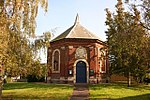Peak Hill, Lincolnshire
Hamlets in LincolnshireLincolnshire geography stubsSouth Holland, LincolnshireUse British English from January 2014

Peak Hill is a hamlet in the South Holland district of Lincolnshire, England. It is situated 4 miles (6 km) south from Spalding and 10 miles (16 km) north-east from Peterborough. The nearest village is Cowbit, about 1 mile (1.6 km) to the north. Peak Hill is on the eastern bank of the New River (an artificial course of the River Welland), and on Barrier Bank, the former A1073 road. In October 2011 the A1073 was rerouted to the east of the hamlet and redesignated as part of the A16.The elevation of the village is given as a 5-metre spot height on the Ordnance Survey maps, but the surrounding spot heights are all 2m.
Excerpt from the Wikipedia article Peak Hill, Lincolnshire (License: CC BY-SA 3.0, Authors, Images).Peak Hill, Lincolnshire
Peak Hill, South Holland Cowbit CP
Geographical coordinates (GPS) Address Nearby Places Show on map
Geographical coordinates (GPS)
| Latitude | Longitude |
|---|---|
| N 52.727846 ° | E -0.128223 ° |
Address
Peak Hill
Peak Hill
PE12 6AW South Holland, Cowbit CP
England, United Kingdom
Open on Google Maps









